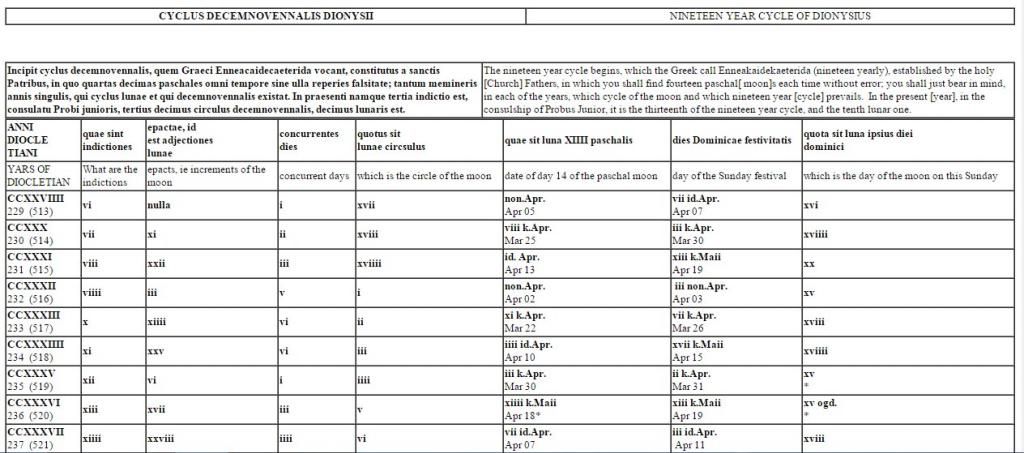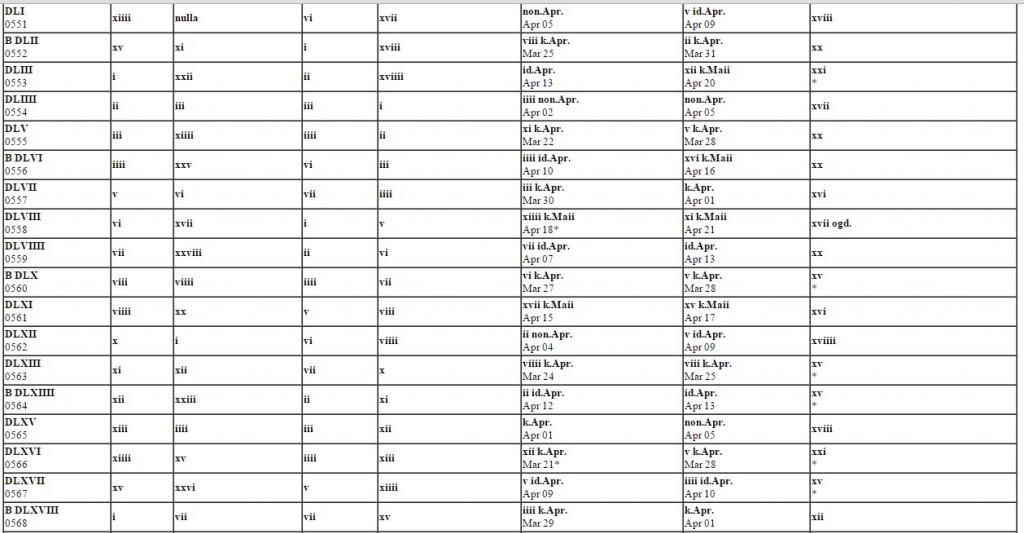Dionisie Exiguul a calculat ca in anul 563 e.n., Pastele iudaic (Passover) va avea loc pe 24 Martie.


http://www.ccel.org/ccel/pearse/morefat ... ter_01.htm
Este absolut imposibil ca Dionisie sa fi facut o asemenea greseala colosala (deoarece ar fi fost suficient sa aplice ciclul Metonian pentru urmatorii 30-40 de ani, iar astfel sa obtina o datare precisa), DECAT DACA nu a trait in acea perioada, iar opera atribuita numelui sau a fost falsificata mult mai tarziu in istorie.
In anul 563 e.n., data Pastelui Iudaic,in calendarul Iulian, este Duminica, 25 Martie:

http://www.staff.science.uu.nl/~gent011 ... text4a.htm
Iar Dionisie habar nu avea de greseala catastrofala comisa: este clar ca falsificatorii istoriei nu stiau de precizia formulelor lui Gauss si au oferit la intamplare date foarte imprecise cand au inventat biografia si opera lui Dionisie Exiguul.
Mai mult, in anul 563 e.n., Pastele coincidea cu Pastele Iudaic (Passover), deci o incalcare a regulilor listate in Cartea despre Pasti.
Ecclesiastical tradition, in accordance with the New Testament, tells that Christ was resurrected on March 25 on Sunday, on the next day after Passover, which, therefore, fell in that time on March 24 (Saturday). These are exactly the conditions used by Dionisius in his calculation of the date of the First Easter.
Dionysius supposedly conducted all these arguments and calculations working with the Easter Book. Having discovered that in the contemporary year 563 (the year 279 of the Diocletian era) the First Easter conditions held, he made a 532-year shift back (the duration of the great indiction, the shift after which the Easter Book entirely recurs) and got the date for the First Easter. But he did not know that Passover (the 14th moon) could not be shifted by 532 years (because of the inaccuracy of the Metonian cycle) and made a mistake: "Dionysius failed, though he did not know that. Indeed, if he really supposed that the First Easter fell on March 25, 31 A.D., then he made a rough mistake as he extrapolated the inaccurate Metonian cycle to 28 previous cycles (that is, for 532 years: 28 x 19 = 532). In fact, Nisan 15, the Passover festival, in the year 31 fell not on Saturday, March 24, but on Tuesday, March 27!". [335, pg. 243: I.A. Klimishin, Calendar and Chronology, in Russian, Nauka, Moscow, 1985]
Din cauza erorilor inerente din ciclul Metonian, aplicat pe o perioada de timp mai mare decat 300 de ani, Exiguus a calculat gresit datarea Pastelui (25 Martie, 31 e.n.).
That is a modern reconstruction of what Dionysius the Little did in the 6th century. It would be all right, but it presupposes that near Dionysius' date of 563 A.D. the 14th moon (Passover) really fell on March 24. It could be that Dionysius was not aware of the inaccuracy of the Metonian cycle and made the mistake shifting Passover from 563 to the same day of March in 31 A.D.
But he could not have been unaware of the date of Passover in the the almost contemporary year 563! To that end it was sufficient to apply the Metonian cycle to the coming 30-40 years; the inaccuracy of the Metonian cycle does not show up for such intervals.
Insa Exiguus nu avea cum sa calculeze data de 24 Martie pentru Pastele anului 563 e.n., pentru ca tot ceea ce ar fi avut de facut este sa fi aplicat ciclul Metonian pentru urmatorii 30-40 de ani (Exiguus a alcatuit Tabelele Pastelui in anul 525 e.n.).
But in 563 Passover (the 14th moon) fell not on March 24, but on Sunday, March 25, that is, it coincided with Easter as determined by the Easter Book. As he specially worked with the calendar situation of almost contemporary year 563 and as he based his calculation of the era "since the birth of Christ" on this situation, Dionysius could not help seeing that, first, the calendar situation in the year 563 did not conform to the Gospels' description and, second, that the coincidence of Easter with Passover in 563 contradicts the essence of the determination of Easter the Easter Book is based on.
Numai ca Pastele a avut loc pe 25 Martie, Duminica, in anul 563 e.n.; deci nu numai ca Exiguus habar nu avea ca aceasta datare incalca imediat regulile listate chiar de el (si care erau gasite si in Cartea Pastelui), dar nimeni dintre "contemporani" nu a indicat greseala colosala comisa.
Therefore, it appears absolutely incredible that the calculations of the First Easter and of the Birth of Christ had been carried out in the 6th century on the basis of the calendar situation of the year 563. It was shown in Sec. 1 that the Easter Book, used by Dionysius, had not been compiled before the 8th century and had been canonized only at the end of the 9th century. Therefore, the calculations carried out by (or ascribed to) Dionysius the Little had not been carried out before the lOth century.
Intr-unul din urmatoarele mesaje, Dr. G. Nosovsky va demonstra ca, Cartea Pastelui nu putea fi alcatuita decat dupa anul 700 e.n. si canonizata cel putin dupa anul 876-877 e.n.
http://www.chronologia.org/en/es_analysis2/index.html (fiecare pagina poate fi accesata direct; Appendix 4, Datarea Sinodului de la Niceea, pg. 390 - 401 si Nasterea lui Christos pg. 401 - 405 )
Dr. G. Nosovsky explica ce este ciclul metonian (metonic):
http://www.scribd.com/doc/74886953/Gleb ... a-Pastelui
Nu trebuie să observăm cerul sau să facem calcule astronomice de fiecare dată; realizând un tabel al lunii pline pentru lunile Martie şi Aprilie pentru oricare perioadă dată de19 ani, ar trebui să fie suficient ca referinţă ulterioară. Motivul este că fazele lunii se repetă la fiecare 19 ani în calendarul Iulian, iar reapariţia ciclului rămâne neschimbată pentru secole la rând, – dacă luna plină cade pe 25 Martie într -un an dat, ea va apărea pe data de 25 Martie peste 19 ani, peste 38 (19x2) ani, etc.
Erorile în ciclu vor apărea după 300 de ani, deoarece dacă acoperim 300 de ani încicluri de 19 ani, luna plină va începe gradual să migreze către locaţia vecină din calendar. Aceiaşi regulă se aplică lunii noi şi tuturor celorlalte faze ale lunii.
525 + 38 = 563
Lucrurile devin si mai interesante.
Autorul exceptionalului studiu The Easter Computus and the Origins of the Christian Era, A. Mosshammer, a reusit sa arate/dovedeasca ca Dionysius Exiguus ar fi alcatuit tabelele pascale in anul 525 e.n. (cronologia oficiala).
ixoyc.net/data/fathers/524.pdf
In the preface to his Easter tables, Dionysius says that he drafted the 19-year cycles to generate a list of Easter dates for a total of 95 years. The list serves, he says, as a continuation of a 95-year table based on calculations made in Alexandria of Egypt, in which the years had been numbered from the year 153 since the accession of the Roman emperor Diocletian to the year 247. At the time of his writing, Dionysius says, there are still six years remaining in that list. Instead of beginning his own table with the year 248, Dionysius says that he decided to designate the years as numbered from the Incarnation of Christ. The list that Dionysius composed begins with the year 532. We can deduce therefore that it was in the year 525 that Dionysius completed his work and wrote the prefatory letter.
Lista alcatuita de Exiguus incepe cu anul 532; si la momentul in care scris Tabelele Pastelui, el mentioneaza ca mai sunt sase ani in lista realizata in Alexandria (Egipt); putem deduce, deci, ca anul in care Exiguus a scris/alcatuit lucrarea este anul 525 e.n.
Deci, o demonstratie superba, utilizand formula absolut precisa a lui G.F. Gauss, care ne arata ca biografia lui Exiguus a fost falsificata cel putin dupa sec. X

